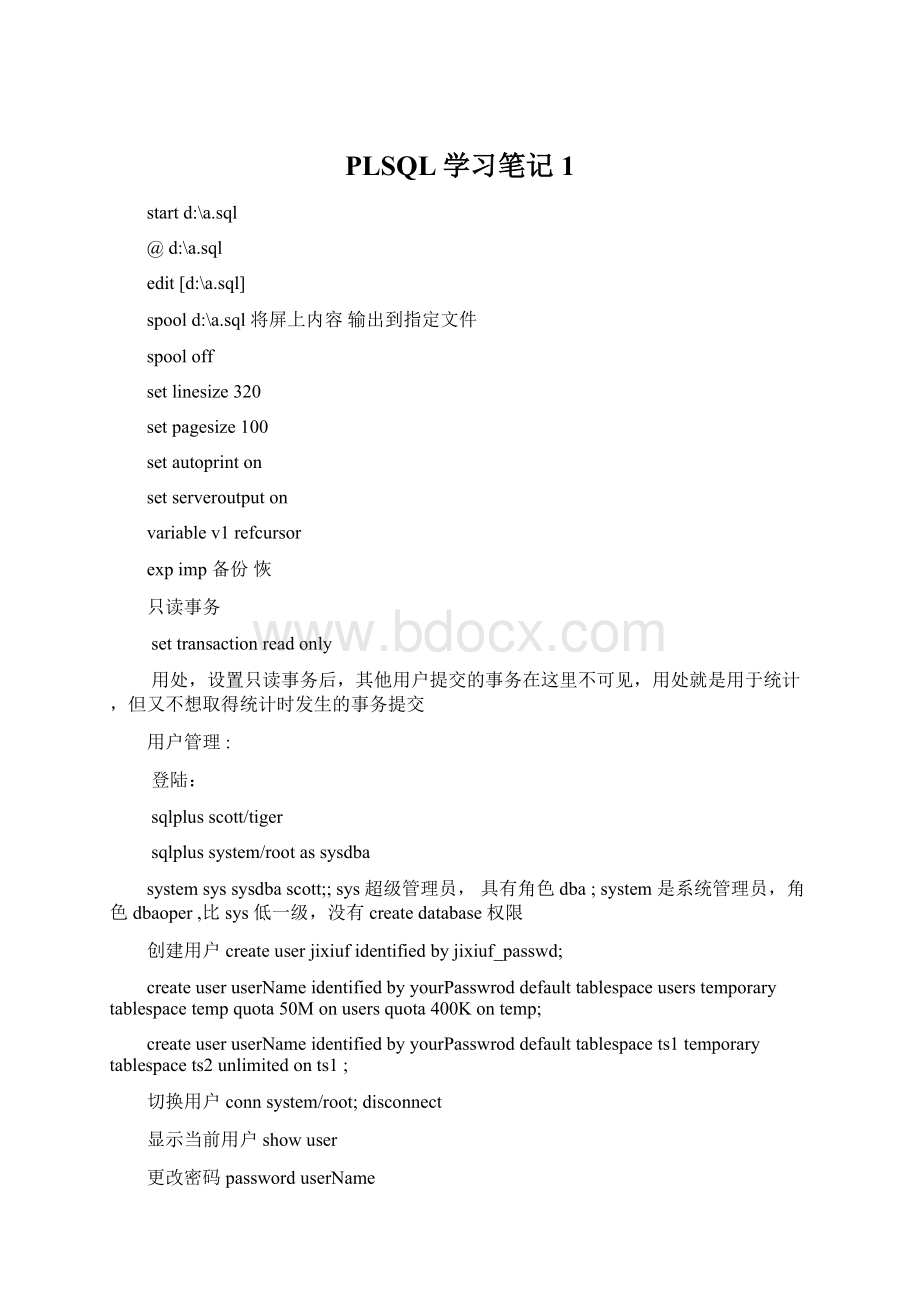PLSQL学习笔记1.docx
《PLSQL学习笔记1.docx》由会员分享,可在线阅读,更多相关《PLSQL学习笔记1.docx(61页珍藏版)》请在冰豆网上搜索。

PLSQL学习笔记1
startd:
\a.sql
@d:
\a.sql
edit[d:
\a.sql]
spoold:
\a.sql将屏上内容输出到指定文件
spooloff
setlinesize320
setpagesize100
setautoprinton
setserveroutputon
variablev1refcursor
expimp备份恢
只读事务
settransactionreadonly
用处,设置只读事务后,其他用户提交的事务在这里不可见,用处就是用于统计,但又不想取得统计时发生的事务提交
用户管理:
登陆:
sqlplusscott/tiger
sqlplussystem/rootassysdba
systemsyssysdbascott;;sys超级管理员,具有角色dba;system是系统管理员,角色dbaoper,比sys低一级,没有createdatabase权限
创建用户createuserjixiufidentifiedbyjixiuf_passwd;
createuseruserNameidentifiedbyyourPasswroddefaulttablespaceuserstemporarytablespacetempquota50Monusersquota400Kontemp;
createuseruserNameidentifiedbyyourPasswroddefaulttablespacets1temporarytablespacets2unlimitedonts1;
切换用户connsystem/root;disconnect
显示当前用户showuser
更改密码passworduserName
删除用户:
dropuserjixiuf[cascade],如果jixiuf用户已经创建过一些表,加cascade级联删除
权限分系统权限和对象权限,系统权限是用户对数据库的控制权,对象权限是用户对其它用户所拥有数据对象的操作权限
对象权限:
如select,updatedelete,createindex
系统权限:
如createsession即连接到数据库
grant[系统特权名][角色]to[用户名列表][public][withadminoption]
grantconnecttojixiuf;角色connect赋予jixiuf此用户可以连接到数据库connect,resource,dba三个重要角色,拥有resource可以在表空间建表,grantresourcetojixiuf
授权:
grantselectontableNametojixiuf[withgrantoption];具有了select*fromuserName.tableName
grantselect,update,deleteonuserName.tableNametojixiuf;
grantallonuserName.tabletojixiuf;增删改查权
如果是对象权限可以加withgrantoption,
若是系统权限则带withadminoption如:
grantconnnecttojixiufwithadminoption;
收回权限:
revokeselectonempfromjixiuf;
如若加了withgrantoption则revoke级联收回其他人的权限,withadminoption好像不收回
建立角色:
createroler1[notidentified];常用
createroler2[identifiedbypassword];
角色授权
系统权限
grantcreatesessiontor1[withadminoption];
grantconectontor1;把connect角色的权限copy一份给r1;select*fromROLE_ROLE_PRIVS;
对象权限
GRANTSELECTONSCOTT.EMPTOR1;
数据字典:
SELECT*FROMDICTWHERETABLE_NAMELIKE'%ROLE%';
使用profile管理用户口令,profile是口令限制,资源限制的命令集合,当建立数据库时,oracle会自动建立名称为default的profile,当建立用户没有指定profile,则默认用此项分配给用户
(1)帐户锁定:
指定用户登陆时最多可以输入口令的次数,指定锁定时间,用dba身份执行此命令
createprofileprofile_name_lock_userlimitfailed_login_attempts3password_lock_time2;
最多尝试3次,3次登陆不成功则不能继续登陆,不成功后允许下次登陆时间为2天后
alteruserjixiufprofileprofile_name_lock_user;
createuserjixiufidentifiedbyjixiudfprofileprofile_name_lock_user;
解锁:
alteruserjixiufacoountunlock;
定期修改密码
createprofilechange_passwordlimitpassword_life_time10password_grace_time2
一个密码用10天后必须修改,宽限期2天,这两天会提示用户修改密码
口令历史:
用户不能使用以前用过的密码
createprofilepassword_historylimitpassword_life_time10password_grace_time2password_reuse_time15;15天后可以重用以前的密码
删除profile
dropprofilepassword_history;对用户作的限制作废
connsystem/root
shutdown;
ORA-01031:
insufficientprivileges
connsystem/rootassysdba只有作为sysdba登陆时才有startupshutdown权限
shutdown;关闭数据库
startup;启动数据库
---------------------------------备份与恢复-----------------------------------------------------
备份与恢复(导入导出)
导出:
三类,导出表,导出方案(一个用户对应一个方案),导出数据库用exp命令
在导入和导出的时候要用到C:
\oracle\product\10.1.0\Db_1\BIN\exp.exe
exphelp=y有帮助提示
(1)导出表(也可以直接输入exp命令,以交互式进行备份)
1导出自已的表:
expuserid=scott/tiger@orcltables=(tableName1,tableName2)file=d:
\tableName.dmp;
2导出别人的表
expuserid=scott/tiger@orcltables=(userName.tableName1,userName.tableName2)file=d:
\tableName.dmp;
3导出表结构,(加一个rows=n)nmeansno
expuserid=scott/tiger@orcltables=(userName.tableName1,userName.tableName2)file=d:
\a.dmprows=n
4直接导出方式:
比常规导出速度快(加一个direct=y,专门用于导出大表)
expuserid=scott/tiger@orcltables=(userName.tableName1,userName.tableName2)file=d:
\a.dmpdirect=y
(2)导出方案
1导出自己方案
expuserid=scott/tiger@orclowner=scottfile=d:
\scott.dmp
2导出其他的人方案
expuserid=system/root@orclowner=(system,scott)file=d:
\scott.dmp
(3)导出数据库(须具有dba权限,或者exp_full_database权限full=yinctype=complete增量备份(第一次complete)
expuserid=system/root@orclfull=yinctype=completefile=d:
\scott.dmp
导入imp(选项:
useridtablesfromusertouserfile=d:
\a.dmpfull=yinctype=complete增量备份rows=n不导入数据ignore=y若表存在则只导数据)
1导入表
(1)导入自已的表
impuserid=scott/tiger@orclfile=d:
\scott.dmptables=emp;
impuserid=system/root@orclfile=d:
\d.dmpfromuser=scotttouser=jixiuftables=emp;
把scott.emp导入到用户jixiuf名下(前提是emp没有外键关联到其他表,否则,因为它关联的表并不在jixiuf中,1法实现主外键关联)
(2)只导入表的结构
impuserid=scott/tiger@orcltables=(emp)file=d:
\scott.dmprows=n
(3)导入数据:
impuserid=scott/tiger@orcltables=(emp)file=d:
\scott.dmpignore=y
2导入方案
(1)导入自身方案
impuserid=scott/tigerfile=d:
\scott.dmp
(2)导入他人方案
impuserid=system/rootfromuser=scotttouser=jixiuffile=d:
\scott.dmp
(3)导入数据库
impuserid=system/rootfull=yfile=d:
\scott.dmp
注意导入的数据可能会与已有的数据重复(如果原来的数据没丢失,却运行了导入一次命令则可能数据重复,慎!
!
!
)
-------------------------数据字典-----------------------------------------------------
user_xxx,all_xxx,dba_xxx如user_tablesdba_roles
dba_users,dba_sys_privsdba_tab_privsdba_col_privsdba_role_privs
selectusername,user_id,passwordfromdba_users;查用户的信息
select*fromdba_role_privswheregrantee='JIXIUF';查jixiuf所具有的role
select*fromdba_roles查oracle具有的role
查一个角色具有的权限(系统权限,对象权限)
descdba_sys_privs
select*fromdba_sys_privswheregrantee='CONNECT';或者select*fromrole_sys_privswhererole='CONNECT'后者以assysdba连接,才可以显示全,?
?
?
select*fromdba_tab_privswheregrantee='RESOURCE';
数据字典的数据字典dict
select*fromdictwherecommontslike'%TABLES%'
SELECT*FROMGLOBAL_NAME;查询当前使用的数据库orcl
----------------表空间-----------------------------------
段区块
createtablespacetsName1datafile'd:
\a.dbf'size20muniformsize128k大小20M区的大小128k
createtablet(idint)tablespacetsName1;
select*fromall_tableswheretablespace_name='TSNAME1';
表空间状态,onlineoffline联机(可读写),脱机(不可读写,系统维护)只读表空间
altertablespacetsName1offline
altertablespacetsName1readonly;
altertablespacetsName1readwrite;
删除表空间
droptablespacetsname1[includingcontents[anddatafiles]]
扩展表空间
1增加数据件
altertablespacetsname1adddatafile'd:
\b.dbf'size10M
2增加datafile的大小
altertablespacetsname1'd:
\b.dbf'resize30M(?
?
?
?
?
)
3设置file自动增长
altertablespacetsname1'd:
\a.dbf'autoextendonnext10mmaxsize500m
移动datafile(磁盘损坏,但datafile区域未坏,可移而用之)
1selecttablespace_namefromdba_data_fileswherefile_name='D:
\A.DBF';
tableSpaceName1
2altertablespacetableSpaceName1offline
3hostmoved:
\a.dbfc:
\a.dbf
4altertablespacetableSpaceName1renamedatafile'd:
\a.dbf'to'c:
\a.dbf'
taltertablespacetableSpaceName1online
相应数据字典:
dba_tablespacesdba_data_files
索引index------------------------------------------------------------------------------------
1键压缩index
--因job列有很多重复信息(即很多人的job是同一类型的),于是普通的索引就会导致job重复生成索引
为此可以压缩(job,name)以节省空间,即同一个job只建一个(无重复现象),而后即的name共享前缀项job,整个(job,name)索引可以节省compress表示压缩,而1表示压缩(job,name)第一项,即job项
createindexidxemponemp(job,ename)compress1;
2分区索引(索引存储在不同的分区)
据表是否分区,分为
2.1本地索引(本地前缀索引,本地无前缀索引)
2.2全局索引(基于整个表建索引)
簇cluster--------------------------------------------------------------------
有公共列的两个或多个表的集合(存储两个表的重复列)减少io节省空间,插入数据慢
簇表中的数据存储在公共数据块中(如有主外键关系的表)
簇键:
簇中的唯一标识符,用于获取行
先建簇,后建组成簇的表
--公共字段可以不只一个
createclusterclass_cluster(classNonumber)tablespaceusers;
为簇建索引
createindexcluster_index_classonclusterclass_cluster;
--表示classes表的classNo_字段存储到class_cluster中
createtableclasses(classNo_number,classNamevarchar2(22))clusterclass_cluster(classNo_);
createtablestudent(studentNamevarchar2(22),studentNonumber,classNonumber)clusterclass_cluster(classNo);
以上两个表的classNoclassNo_其实都是class_cluster的
---------------------------------------------------------------------------------------------
添加字段
altertablestudentadd(desc_varchar2(20));
修改字段长度:
altertablestudentmodify(description_varchar2(300));
删除一个字段
altertablestudentdropcolumncol_name;
修改表名;
renamestudnttostu;
修改日期格式
altersessionsetnls_date_format='yyyy-mm-dd';
添加空值
insertintostudvalues(1,null);
更新
updatestudentsetsex='nu',name=''wherexh='';
删除
deletefromstudent
droptablestudent
truncatetablestudent,不写日志
altertableempaddconstraintpk_p1primarykey(id);
altertableempdropconstraintpk_p1;
回滚
savepointa;
deletefromstudnet;
rollbacktoa;
字符合并两个竖线
select'姓名:
'||namefromemp;
字符函数
lower()upper()substr(str,pos,len)replace(str,oldStr,newStr)
null-->default如果comm为null则以0为默认值
selectnvl(comm,0)fromemp;
日期函数:
selectcurrent_date,sysdatefromdual;
select*fromempwheresysdate>add_months(hiredate,8)查八个月以前的员工入职的
selectsysdate-hiredateas入职天数fromemp;
当月最后一天
selecthiredate,last_day(hiredate)fromemp;
selectto_char(hiredate,'yyyy-mm-ddhh24:
mi:
ss')fromemp;
updateempsethiredate=to_date('1988-09-09','yyyy-mm-dd');
当前使用的数据库名:
selectsys_context('USERENV','db_name')FROMDUAL;
当前使用的语言
selectsys_context('USERENV','language')fromdual;
selectsys_context('USERENV','session_user')fromdual;
selectsys_context('USERENV','current_schema')fromdual;
-----------------------------------------------------------------------------------------
------------------------------ps/sql-----------------------------------------------
procedure---------------------------------------------------------------------------
可以用desc查一个procedure
descsp_pro1;
可以在procedure中使用return,结束此procedure
user_source表中有更详细的信息
selecttextfromuser_sourcewherename='SP_PRO1';
pl/sql以块为单位
-----------------------------
--注意,procedure的名称是sp_pro1如果有参数,则声明如同
--createorreplaceproceduresp_pro1(namevarchar2)is
--无参数时加上括号好像编译不通过
createorreplaceproceduresp_pro1is
--此处不需要declare关键字
v_var_namevarchar2(255);
begin
insertintoscott.tvalues
(1);
end;
--注意end后的分号
/
--输入斜杠完成
--调用callsp_pro1();或者execsp